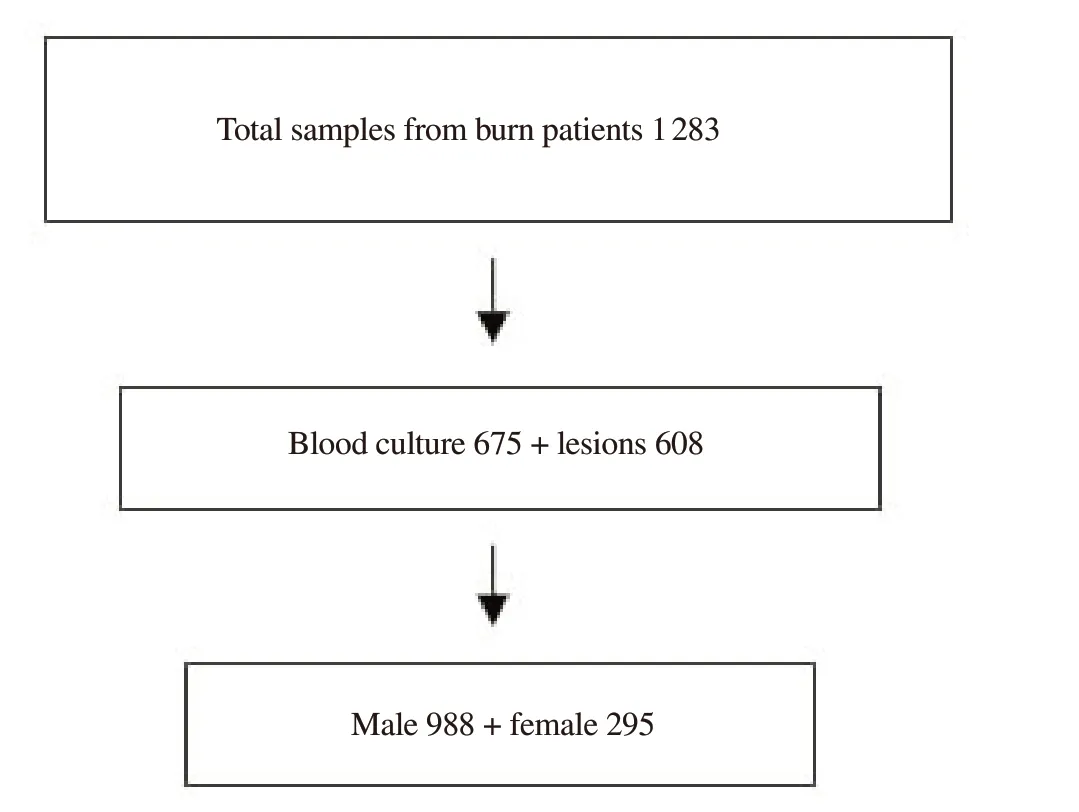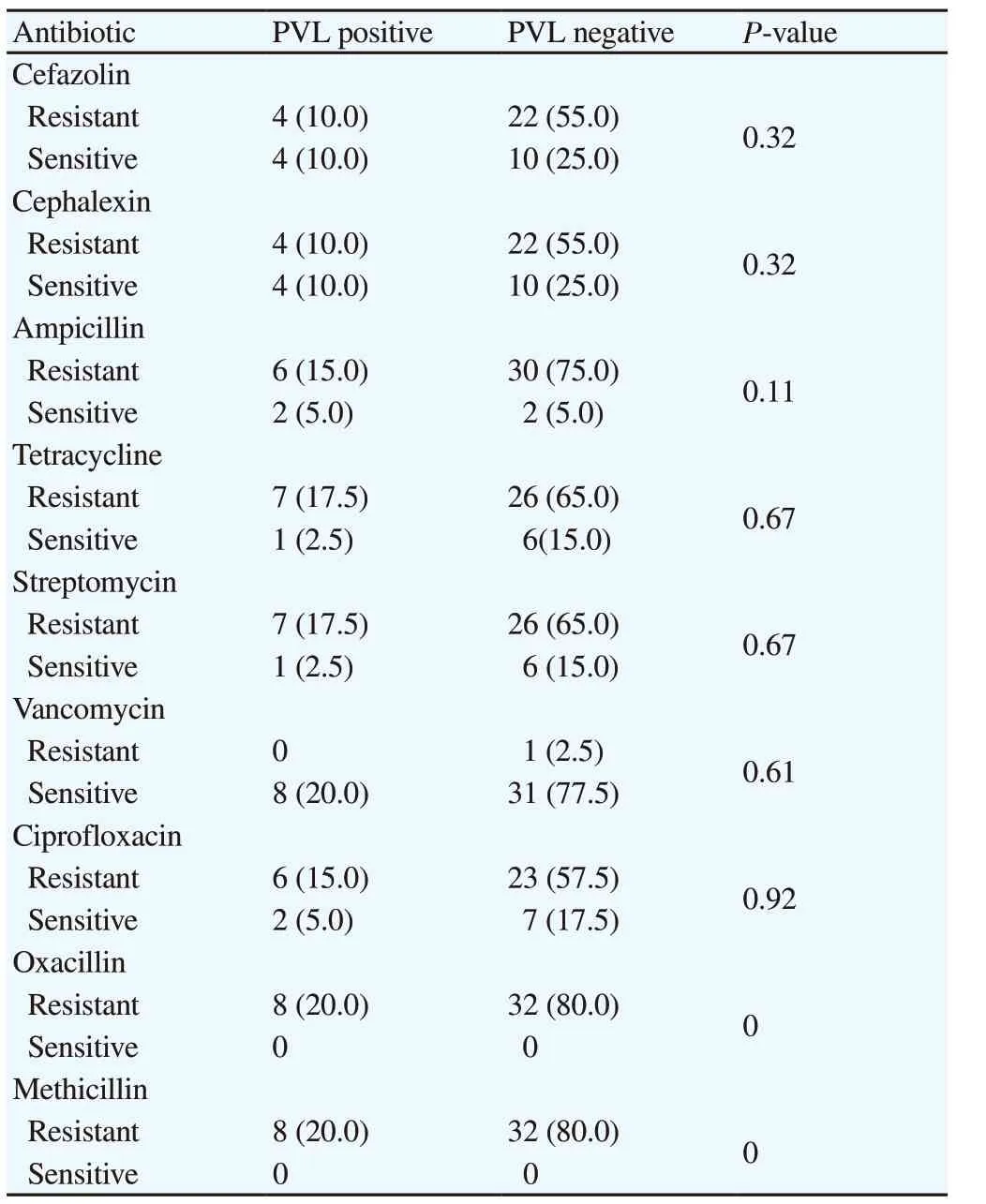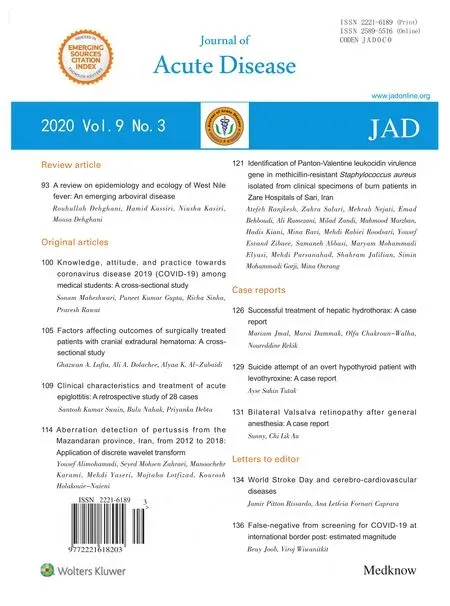Identification of Panton-Valentine leukocidin virulence gene in methicillinresistant Staphylococcus aureus isolated from clinical specimens of burn patients in Zare Hospitals of Sari, Iran
Atefeh Ranjkesh, Zahra Salari, Mehrab Nejati, Emad Behboudi, Ali Ramezani, Milad Zandi, Mahmood Marzban, Hadis Kiani, Mina Bavi, Mehdi Rabiei Roodsari, Yousef Esvand Zibaee, Samaneh Abbasi, Maryam Mohammadi Elyasi, Mehdi Parsanahad, Shahram Jalilian, Simin Mohammadi Gorji, Mina Owrang✉
1Faculty of Medicine, Sari Branch, Islamic Azad University, Sari, Iran
2School of Medicine, Bam University of Medical Sciences, Bam, Iran
3Department of Microbiology, Faculty of Medicine, Golestan University of Medical Sciences, Gorgan, Iran
4Virology Department, School of Medicine, Ahvaz Jundishapur University of Medical Sciences, Ahvaz, Iran
5Nursing School of Tabas, Birjand University of Medical Sciences, Birjand, Iran
6Department of Virology, School of Public Health, Tehran University of Medical Sciences, Tehran, Iran
7Department of Laboratory Sciences, Borujerd Branch Islamic Azad University, Borujerd, Iran
8Abadan Faculty of Medical Sciences, Abadan, Iran
9School of Paramedical Sciences, Dezful University of Medical Sciences, Dezful, Iran
ABSTRACT
KEYWORDS: Methicillin; Resistance; Panton-Valentine leukocidin; PCR; Staphylococcus aureus
1. Introduction
Staphylococcus aureus (S. aureus) is a human pathogen which is implicated in nosocomial infections. Because of the complexity of various virulence factors, it becomes a serious threat to human. Among infectious organisms in burn patients, S. aureus, particularly methicillin-resistant S. aureus (MRSA), is a major challenge with the potential to cause significant morbidity and mortality[1,2]. For the first time, MRSA was reported in the 1960s as soon as the recognition of the penicillinase-resistant β-lactam antibiotic methicillin[3]. The burn lesion is commonly exposed to bacterial colonization and infection because of the deficiency of the normal skin physical barrier and the additional decrease in cellmediated immunity[3]. Also, the ability of Staphylococci to survive in polymorphonuclear leukocytes is an extra problem. Furthermore, polymorphonuclear leukocytes bactericidal activity is weak in burned patients, which allows bacteria to survive for a longer time[4]. S. aureus has several virulence factors in both cell-associated and secreted kinds which enhance cellular adhesion, bacterial proliferation, invasion and evasion of immune responses. These virulence factors include Panton-Valentine leukocidin (PVL), toxic shock syndrome toxin 1 (TSST-1), staphylococcal enterotoxins (SEs) and hemolysins[5]. PVL is a toxin which is commonly involved in the skin and soft tissue infections, necrotizing pneumonia, diffuse cellulitis and osteomyelitis[6]. Some of the toxins like TSST-1 and SEs are superantigens. Interestingly, more than 20 superantigens have been discovered in S. aureus strains, and at least 80% of the main strains have at least one. Bacterial toxins SEs are involved in staphylococcal food poisoning, whereas toxic shock syndrome and staphylococcal scalded skin syndrome are mediated by TSST-1 and exfoliative toxins[7].
The aim of the current study was to evaluate the prevalence of genes encoding leukocidins in S. aureus strains with resistance and sensitivity to methicillin isolated from burn patients in Shaheed Zare Hospital, Sari, Iran.
2. Patients and methods
The present study was approved by the Ethic Committee Faculty of Medicine, Sari Branch, Islamic Azad University, Sari, Iran with the number 208 305 139 520 25. In addition, the consent form was obtained from all patients.
From November 2016 to July 2017, 1 283 isolates were taken from burned patients in Shahid Zare Burn Hospital, Sari, Iran. The blood culture 675 (53.36%) and swab samples from burned lesions of the patients 608 (48.06%) were collected as soon as clinical symptoms of infection appeared and then were transferred to the laboratory (Figure 1). Standard biochemical tests such as catalase, coagulase, mannitol salt agar, disk agar diffusion (DAD), antibiogram, and DNA test were used to detect S. aureus strains[8]. Totally 104 staphylococci and 78 aureus were detected. Then suspensions inoculate in sterile, molar Hinton agar medium. After a few minutes the antibiotic discs were laid with 22 mm distance and 16 mm disctance from plat walls. Plates then were ancubated in 37 ℃ for 24 h and then the diameter of the halo of Lacking growth for all antibiotics was measured and methicillin-resistant strains were selected for polymerase chain reaction (PCR) to detect genes of Leukocidin Pentone valentine. DNA was extracted from the bacterial colony by a commercial DNA isolation kit (Pouya gene Azma kit)[9]. And PCR was used to detect the pvl gene representing MRSA strains. The primers were as following: F-ATCATTAGGTAAAATGTCTGCACATGATCC A and R-GCATCAASTGTATTGGATAGCCAAAAGC that can amplify a DNA fragment with size 433 bp[10]. We used S. aureus strain ACTC49775 as a positive control. Eppendorf thermocycler was used for DNA amplification (Roche Co., Germany). DNA amplification was performed in a final volume of 25 µL containing 12 µL of MgCl2, 0.2 mM of dNTP mix, 1 µL of each primer, 1 U of Taq polymerase, 5 µL PCR buffer and 5 µL of template DNA.

Figure 1. The study flow chart.
The amplification was performed with an initial denaturation at 94 ℃ for 5 min, followed by 30 cycles of denaturation at 94 ℃ for 30 s, annealing at 61 ℃ for 30 s, and extension at 72 ℃ for 60 s with a final extension at 72 ℃ for 5 min. The PCR products were separated on 1.5% (w/v) agarose gel with 0.5 mg/mL of loading dye and were analyzed by gel electrophoresis.
The data were analyzed using the Statistical Package for the Social Sciences 22 (SPSS Inc., Chicago, IL, USA). Qualitative variables were assayed using the Chi-square test. The significance level of the tests was set at α=0.05.
通过以上关于马克思宗教观三个研究向度的概括,可以看出,目前的研究已经形成稳定的研究入路和方向,学界着力于对于马克思宗教思想本真面目的恢复和深度探究,并取得具有一定特色的研究成果。但是同时应该看到,目前的研究对于马克思宗教批判与人的解放、自由发展的终极关怀维度之间内在关联性的梳理工作做得不够,缺少这一维度马克思思想进程的整体性研究。
3. Results
These samples were isolated from 988 (77.5%) male and 295 (22.5%) female patients. The mean age was (35.17±17.73) years old (range 1 to 62 years), and the mean of total burns was (35.12±21.28)% (range 8%-99%). A total of 503 samples were positive for bacterial infection, including 399 (79.32%) infected with Gram-negative bacteria and 104 (20.68%) with Gram-positive staphylococci. Of the total 503 specimens, 399 specimens belonged to the Gram-negative bacterium, including 20 (3.98%) Escherichia coli, 30 (5.96%) Serratia, 175 (34.79%) Acinetobacter, 40 (7.95%) Enterobacter, 30 (5.96%) Proteus, 6 (1.19%) Hafnia, 5 (0.99%) Klebsiella and 48 (9.54%) Pseudomonas. A total of 78 (15.51%) of the tested isolates were identified as S. aureus. Of these 78 S. aureus samples, 40 (51.28%) were resistance and 38 (48.72%) were sensitive to methicillin. Totally 80% of S. aureus positive samples were PYL negative and only 20% were PYL positive. Male and female patients showed no significant difference in positive positivity of the pvl gene (16.12% vs. 33.33%) (P=0.25). Of the 40 resistance samples, all S. aureus samples were resistant to methicillin and oxacillin antibiotics, followed by antibiotic vancomycin (97.50%). The resistance rates of ampicillin, tetracycline, and streptomycin were 90.00%, 82.50%, and 82.50% (Figure 2). Male and female patients showed significant differences in resistance rate and susceptibility rate to cefazolin (P=0.024), cephalexin (P=0.024) and tetracycline (P=0.008). A total of 74.19% of the bacterial samples from male patients were resistance to cefazolin and cephalexin antibiotics, 35.0% of female patients were resistance to cefazolin and cephalexin antibiotics, with significant difference (P=0.024). Male and female patients also showed significant differences in resistance rate of ampicillin antibiotics (96.77% vs. 66.6%) (P=0.008) (Table 1). Besides, there was no significant difference in bacterial resistance or susceptibility to antibiotics between samples with or without the pvl gene (Table 2).

Table 1. Sensitivity and resistance to different antibiotics between male and female patients.

Table 2. Resistance and susceptibility rate of samples with or without the pvl gene [n(%)].

Figure 1. Bacterial sensitivity and resistance to different antibiotics (%).
4. Discussion
Today, antibiotic resistance becomes one of the major problems in medicine, and widespread antibiotic abuse plays a key role in the emergence of resistant bacteria. S. aureus as the second nosocomial pathogen is part of the natural flora of the skin and nasal ducts. This bacterium is resistant to a wide range of antibiotics. Recent studies have shown that S. aureus strains PVL has a high virulence and is responsible for severe infections such as bone marrow, joint, and necrotizing pneumonia.
In the present study, high rate of resistance against methicillin and oxacillin (100%), ampicillin (90%), tetracycline (65%), streptomycin (82.5%), ciprofloxacin (76.3%), cefazolin (65%) and cephalexin (65%) were observed in the isolated community S. aureus strains. In a study by Karmakar et al., resistance of S. aureus isolates to ampicillin (91%), nalidixic acid (91%), chloramphenicol (36%), streptomycin (27%), kanamycin (55%), cefoxitin (68%), novobiocin (64%), and erythromycin (82%) was found[11]. This report confirms that S. aureus is resistant to a wide range of antibiotics. In a study, Ruu et al. studied 100 samples with S. aureus using the real time PCR method and showed that the pvl gene was negative in 51 cases (58% PVL negatives methicillinsensitive S. aureus (MSSA) and 42% negative PVL MRSA) and 49 cases positive (46% positive PVLs MSSA and 54% PVL positive MRSA)[12]. These results were not matched to our research findings. In our research 8 cases (20%) carried positive PVL strains (100% MRSA) and 32 cases (80%) were negative PVL strains (100% MRSA). In another study in the UK, the results revealed that less than 2% of S. aureus strains carry the pvl gene and this gene can be transported both in the MRSA and MSSA strains.
Worldwide emergence of MRSA is a serious concern to public health and a challenge to clinicians. Numerous factors are involved in drug resistance and the virulence of S. aureus. In the late 1990s first PVL positive MRSA was identified and these strains have been disseminated worldwide recently[13]. There are several studies to assess the role of PVL in enhancing the virulence of S. aureus strains and their pathogenicity. PVL increases the pathogenicity of S. aureus via necrosis, facilitates apoptosis and reduces immune system polymorphonuclear and mononuclear cells, and is responsible for mortality and morbidity[14]. PVL is commonly recognized as a marker for colonized MRSA, necessary for deep dermal infections and soft tissues[15,16]. It is considered that the global measure of PVL among MRSA isolates is different. Reports have been demonstrated that a lower prevalence of PVL (5% in France, 4.9% in the UK, 8.1% in Saudi Arabia, and 14.3% in Bangladesh)[14,17-19], which reflect the noteworthy difference in the prevalence of PVL in various geographical areas and populations. Kaur et al.[20] from India have revealed 62.85% prevalence of PVL in MRSA and MSSA (MRSA: 85.1% and MSSA: 48.8%), higher prevalence of PVL in MRSA compared to current study findings. Also, Johnsson et al.[21] have reported pvl gene in only 1 isolate (1%) from 65 cases suffered S. aureus bacteremia, in 2 (2.19%) isolates from 91 cases suffered cutaneous infections, and in 4 (7.27%) isolates from 55 patients suffered respiratory tract infections. Rostamzad et al.[22] demonstrated that from 32 MRSA isolates, 13 (40.62%) isolates were positive for pvl gene among hospitals isolates. PVL in children (<14 years of age) was more prevalent in comparison to adult patients. Parallel reports were acquired in another study from India[23]. Epidemiological studies offered that high pathogenicity of community-acquired MRSA is correlated with the pvl gene but direct evidence of this correlation is still retaining to be discovered[24]. In S. aureus, through PVL expression of toxins and other factors can be evaluated in in vivo[25]. Furthermore, expression of the pvl gene can be facilitated by sub-MIC values of β-lactam antibiotics[26]. The health education is week in the studied community and they usually use β-lactam antibiotics to treat any infections; probably this is the disturbing factor of high expression of the pvl in in vitro. Consequently, detecting of pvl gene in isolated S. aureus colonies indicates the emergence of pathogenic S. aureus in population in the studied area.
The present study reveals the increased rate of multi-drug resistant S. aureus infections in public. The prevalence of the pvl gene among the MRSA isolates in this study was low. The presence of PVL in multi-drug resistant bacteria such as MRSA can be a lethal and challenging condition for clinicians.
Conflict of interest statement
The authors report no conflict of interest.
Fouding project
This article was financially supported by Sari Branch, Islamic Azad University with grant number 410.
Authors’ contribution
M.O. and S.M.G. design of the work; A.R., A.R., and M.M. data collection, S.A., H.K, and M.P. data analysis, Z.S. interpretation, M.M.E. and A.R. drafting the article, S.M.G. critical revision of the article, M.O. final approval of the version.
 Journal of Acute Disease2020年3期
Journal of Acute Disease2020年3期
- Journal of Acute Disease的其它文章
- Bilateral Valsalva retinopathy after general anesthesia: A case report
- Suicide attempt of an overt hypothyroid patient with levothyroxine: A case report
- Successful treatment of hepatic hydrothorax: A case report
- Aberration detection of pertussis from the Mazandaran province, Iran, from 2012 to 2018: Application of discrete wavelet transform
- Clinical characteristics and treatment of acute epiglottitis: A retrospective study of 28 cases
- Factors affecting outcomes of surgically treated patients with cranial extradural hematoma: A cross-sectional study
